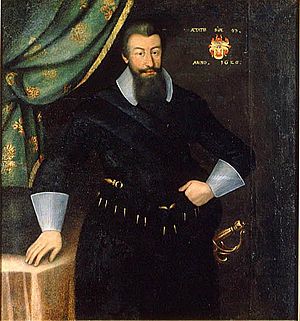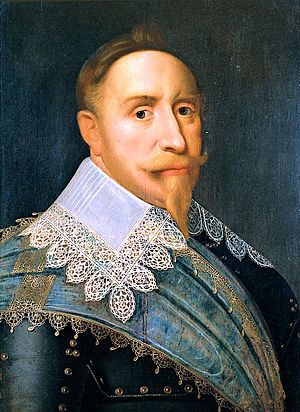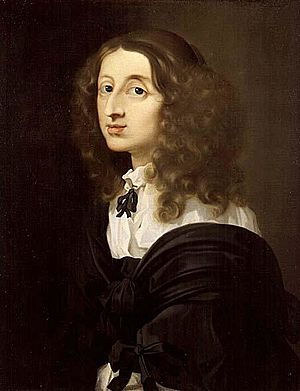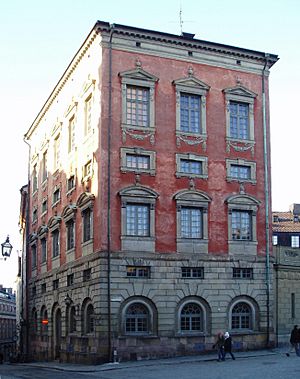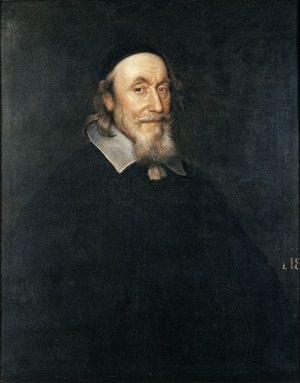Axel Oxenstierna facts for kids
Quick facts for kids
The High Well Born
Count Axel Oxenstierna
|
|
|---|---|
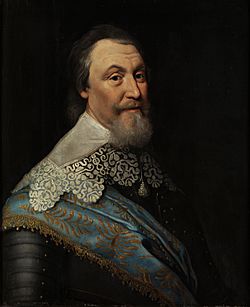 |
|
| Lord High Chancellor of Sweden Rikskansler |
|
| In office 1612–1654 |
|
| Preceded by | Svante Turesson Bielke |
| Succeeded by | Erik Oxenstierna |
| Monarch | |
| Governor-General of Riga | |
| In office 1622–1626 |
|
| Preceded by | Office created |
| Succeeded by | ? |
| Governor-General of Prussia | |
| In office 1626–1631 |
|
| Preceded by | Office created |
| Succeeded by | Office abolished |
| Personal details | |
| Born | 16 June 1583 Fånö, Uppland, Sweden |
| Died | 28 August 1654 (aged 71) Stockholm, Sweden |
| Spouse | Anna Åkesdotter Bååt |
| Children | Gustaf Oxenstierna, Johan Oxenstierna, Catharina Oxenstierna, Christina Oxenstierna, Beata Oxenstierna, Barbro Oxenstierna, Åke Oxenstierna, Maria Oxenstierna, Gabriel Oxenstierna, Jakob Oxenstierna, Erik Oxenstierna |
| Residence | Tidö Castle |
| Occupation | Statesman |
| Signature | |
Axel Oxenstierna (1583–1654) was a very important Swedish statesman. He became a key advisor to the King and Queen, serving as Sweden's Lord High Chancellor from 1612 until he died. He worked closely with King Gustavus Adolphus and later with Queen Christina.
Many people consider Oxenstierna one of the most influential figures in Swedish history. He played a huge role during the Thirty Years' War. He also helped create the modern way the Swedish government is organized, including setting up the counties we know today.
Contents
Who Was Axel Oxenstierna?
Axel Oxenstierna was born on June 16, 1583, in Fånö, Sweden. His parents, Gustaf Gabrielsson Oxenstierna and Barbro Axelsdotter Bielke, came from old and powerful noble families. These families had held important positions in the government and church for many years.
After his father passed away, Axel's mother made sure he and his brothers, Christer and Gustaf, studied abroad. They attended universities in Rostock, Wittenberg, and Jena. When he returned home in 1603, he started working for King Charles IX of Sweden.
One interesting thing about Oxenstierna was his knowledge of the Scots language. This shows how important the Scottish community was in Sweden back then. He even wrote official letters in Scots to his Scottish counterparts.
Axel's Important Career
Early Diplomatic Missions (1606–1611)
In 1606, Axel went on his first diplomatic trip to Germany. While he was away, he was appointed to the Privy Council, which was a group of the king's closest advisors. From then on, Oxenstierna became one of the king's most trusted helpers.
He traveled to Tallinn in 1609 to collect tributes for King Charles. He also tried to warn the king about the intentions of Danish King Christian IV. In 1610, he went to Copenhagen to try and stop a war with Denmark, but he wasn't successful. The next year, Danish forces crossed the border, starting the Kalmar War.
In late 1611, King Charles died. His son, Gustavus Adolphus, was only 17. Even though he was young, the leaders agreed to let him become king. In return, the young king promised to give more privileges to the nobles and appointed Axel Oxenstierna as Lord High Chancellor.
Lord High Chancellor and Governor-General (1612–1629)
On January 6, 1612, Oxenstierna officially became the Lord High Chancellor. He quickly started to organize and improve every part of the government. At this time, Sweden was fighting three wars: against Denmark, Poland-Lithuania, and Russia.
Oxenstierna's first major job was to make peace in some of these wars. The war with Denmark was the most dangerous. He led the Swedish team in peace talks, which resulted in the Treaty of Knäred in 1613. For his hard work, he received new titles and lands.
When King Gustavus was away fighting in Livonia and Finland (1614–1616), Oxenstierna acted as his representative. He also helped arrange the marriage of the king's sister, Princess Catharina. In 1617, Oxenstierna was knighted. In 1620, he led a group to Berlin to arrange the marriage between Gustavus and Maria Eleonora of Brandenburg.
During the king's wars with Russia and Poland, Oxenstierna was in charge of supplying the armies and fleets. This included getting men and money. King Gustavus was very happy with Oxenstierna's work. In 1622, the king asked him to come to Livonia and made him Governor-General of Riga. Riga was a very important city during the war against Poland.
His success in Livonia earned him more rewards, including several castles. In 1623, he helped with peace talks that led to a truce with Poland. He also prevented a new war with Denmark in 1624. The war with Poland started again in 1626. On October 7, Oxenstierna became Governor-General of the newly taken Swedish lands in Prussia. In 1629, he made a good peace deal with Poland-Lithuania called the Truce of Altmark.
Oxenstierna was great at diplomacy, but also at organizing. He gathered money and troops for the attack in Prussia in 1626. He managed everything in Prussia, just like he had in Livonia. This included taxes, forts, and even the grain trade. By the late 1620s, Elbląg, where Oxenstierna lived, became a major Swedish power center, second only to Stockholm.
Role in the Thirty Years' War (1630–1636)
When Sweden joined the Thirty Years' War in 1630, the money from Prussia and the food supplies Oxenstierna got were very important. He also got loans from foreign business people. This helped Sweden hire many soldiers for the army in Germany.
After the Battle of Breitenfeld in 1631, King Gustavus asked Oxenstierna to join him in Germany. When the king was away in 1632, Oxenstierna was in charge of all the German generals and princes working for Sweden. Even though he never fought a battle, he stopped the Spanish troops by using smart strategies. He also managed to send many more soldiers to King Gustavus in the summer of 1632.
On November 6, 1632, King Gustavus Adolphus died in the Battle of Lützen (1632). This meant Oxenstierna became the top commander of the Swedish troops in Germany. He moved his main office to Mainz, which became like a new Swedish capital. Oxenstierna now controlled the large area the Swedish army had taken in Germany. He was even offered the position of prince-elector of Mainz, but he turned it down.
When King Gustavus died, his only child, Christina, was almost six years old. A group of advisors, called a regency council, ruled Sweden until she turned 18. Lord High Chancellor Oxenstierna led this council. He also wrote a new constitution for Sweden called the Instrument of Government (1634).
After the king's death, some people in the council wanted Sweden to leave the war in Germany. This was especially true after a big defeat at Nördlingen in 1634. But Oxenstierna believed Sweden should stay in the war to get something back for all their sacrifices. His opinion won. The defeat at Nördlingen made things very hard for him. He had to ask France for help. But he knew that Richelieu needed the Swedish armies as much as he needed money. So, he didn't give away too much in return for help. In 1636, he made a new agreement with France. Swedish troops stayed in Germany until the war ended in 1648. However, Oxenstierna left Germany and returned to Stockholm in 1636.
Back in Sweden (1636–1654)
Back in Sweden, Oxenstierna took his place in Queen Christina's regency. He became the young queen's teacher in how to run the country. His presence was so strong that for the next nine years, his opinion, especially on foreign matters, was the most important in the Privy Council.
The Torstenson War
In May 1643, the Swedish Privy Council decided to attack Denmark. This war, called the Torstenson War, was largely Oxenstierna's idea. The goal was to take land from Denmark and stop paying the Danish Sound Dues, which were tolls for ships passing through a strait. Oxenstierna felt it was the right time to settle old scores with Denmark.
Swedish troops attacked Jutland from Germany, while another group attacked Scania. The war was decided in the naval battle of Fehmarn Belt in 1644. The Swedish Navy completely defeated the Danish Navy. This defeat left the Danish islands open to invasion. Denmark then asked for peace. Oxenstierna was personally involved in the talks that led to the Treaty of Brömsebro. Through this treaty, Sweden gained Gotland, Saaremaa, Jämtland, Härjedalen, and Halland for thirty years. Soon after, Oxenstierna was given the title of Count of Södermöre.
Queen Christina and Her Abdication
When Queen Christina became old enough to rule on her own, she tried to push Oxenstierna, her old teacher, aside. Their relationship was not good. Oxenstierna believed that Sweden didn't gain enough from the Peace of Westphalia (which ended the Thirty Years' War) because Christina interfered too much. Sweden only gained Pomerania, Usedom, Wollin, Wismar, and Bremen-Verden.
A few years later, the queen wanted to give up her throne. At first, Oxenstierna was against this. He worried about what would happen to Sweden with her chosen successor, Charles X Gustav. However, the chancellor changed his mind about Charles Gustav. He then helped Christina with her abdication. Oxenstierna died a few months after the new king took the throne.
Death

Axel Oxenstierna passed away in Stockholm on August 28, 1654. He was first buried in Storkyrkan in Stockholm. Later, his body was moved to Jäder Church, near his family estate at Fiholm. A special vault, called Oxenstiernska gravvalvet, was built there. Many members of the Oxenstierna family, including Axel and his wife Anna, are buried in this vault.
Personal Life
Family
On June 5, 1608, Axel Oxenstierna married Anna Åkesdotter Bååt. The wedding took place at Fiholm Castle, which belonged to the Oxenstierna family. They had 13 children, but only five lived past childhood:
- Gustaf (1609–1629)
- Johan (1611–1657), who became a privy councillor.
- Christina (1612–1631), who married Field Marshal Gustav Horn.
- Catharina (1612–1661), Christina's twin.
- Erik (1624–1656), who also served as Lord High Chancellor after his father's death.
Axel Oxenstierna's wife, Anna, died in 1649.
Properties
Oxenstierna owned many large estates and mansions. These included palaces in Estonia, Latvia, Finland, and Stockholm. His most important mansion was Tidö Castle in Västmanland.
Axel Oxenstierna's Impact and Legacy
Modernizing Sweden
Axel Oxenstierna is perhaps best known for creating a clear system for how the government should work. He was involved in many big changes in the 1610s and 1620s. During this time, the Swedish government became much more modern and efficient. This was very important for Sweden to become a powerful empire.
He helped reform many areas, such as:
- How the army and navy were organized and recruited.
- Trade and industry rules.
- Local government.
- The system for higher education.
- The justice system.
The borders of Sweden's administrative counties today still largely follow the boundaries Oxenstierna set up in the 17th century.
Working with King Gustavus Adolphus
Oxenstierna wouldn't have been so influential if he hadn't earned the king's trust. From 1612, when he became Lord High Chancellor, until King Gustavus Adolphus died in 1632, the two men had a long and successful partnership. They seemed to balance each other out. Oxenstierna himself said his "cool" nature balanced the king's "heat."
Sometimes, the chancellor had to make the king's spontaneous plans actually work. When it came to joining the Thirty Years' War, Oxenstierna wasn't as excited as the king. But since the king's decision was final, Oxenstierna supported his wish. Oxenstierna often stepped in to smooth over problems caused by the king's sometimes harsh behavior. The king often praised Oxenstierna's work and asked for his advice on almost everything.
The Instrument of Government of 1634
Oxenstierna played a big part in creating the rules for the House of Knights in 1626. After King Gustavus Adolphus died, Oxenstierna was the main person behind the Instrument of Government of 1634. This new constitution made it clear how the five main government departments, led by the Great Officers of the Realm, should be organized.
Oxenstierna pushed this new government structure through, even though there was some opposition. He said that the new system reflected the wishes of the late King Gustavus. This made it hard for others to argue against it.
His Ideas and Beliefs
Oxenstierna is seen as a very practical thinker who was willing to change his mind. There are stories of him rejecting laws he had introduced earlier, admitting he knew better now. His way of looking at things, rethinking them, testing them, and sometimes changing his mind is a big part of his legacy.
When he noticed there weren't enough young noblemen to fill government jobs, he worked to make it easier for boys from non-noble families to get a good education. He also gave them the chance to become nobles themselves later. Because of this, some people call him the father of Swedish meritocracy, where people get ahead based on their skills, not just their birth.
Oxenstierna also supported mercantilism, which is an economic idea about a country's wealth. He believed in encouraging immigration and free business.
In Germany, Oxenstierna became a scary character in a version of the popular German lullaby "Schlaf, Kindlein, Schlaf!" He was called "Ochsenstern" in the song.
What Others Thought of Oxenstierna
- The Dutch thinker Hugo Grotius called Oxenstierna "the greatest man of the century."
- French Cardinal Richelieu said he was "an inexhaustible source of fine advice."
- Richelieu's successor, Cardinal Mazarin, said that if all the ministers in Europe were on the same ship, Oxenstierna would be given the steering wheel.
- Pope Urban VIII claimed Oxenstierna was one of the most excellent men the world had ever seen.
Famous Quote
"Do you not know, my son, with how very little wisdom the world is governed?" This famous quote was in a letter he wrote to his son Johan in 1648. The original Latin was: An nescis, mi fili, quantilla prudentia mundus regatur?
Even though some people also say Cardinal Richelieu said it, this is probably the most famous Swedish quote in the English-speaking world. Oxenstierna said these words to encourage his son, who was a delegate at the peace talks that would lead to the Peace of Westphalia. His son was worried about being able to hold his own among very experienced and important statesmen.
Fictional Portrayals
Film and TV
Oxenstierna has been shown in plays and movies many times. This is mainly because of his role as a mentor and guardian to the mysterious Queen Christina.
- He was played by Lewis Stone in the 1933 Hollywood movie Queen Christina, which starred Greta Garbo.
- Cyril Cusack played him in Anthony Harvey's The Abdication (1974).
- Michael Nyqvist played him in Mika Kaurismäki's The Girl King (2015).
On Stage
- Samuel Ahlgren (1764–1816) played Oxenstierna in Drottning Kristina (1790), a play written by King Gustav III of Sweden.
- In August Strindberg's 1901 play Kristina, Oxenstierna is shown as a serious, practical person who criticizes Christina's fancy lifestyle and her gifts to her favorites.
- The character of Oxenstierna was first sung by Giovanni Carlo Casanova in Jacopo Foroni's 1849 opera Cristina, regina di Svezia.
Literature
Oxenstierna is an important character in the Ring of Fire series of books by Eric Flint and others. In the fifth main book, 1636: The Saxon Uprising, he tries to start a counter-revolution to bring back the power of the nobles while Gustav II Adolf is unable to rule. But Gustav Adolf recovers, and Oxenstierna is punished for his betrayal.
Games
The computer strategy game Europa Universalis IV has several events in the game that are related to Oxenstierna's reforms and his time as a regent.
See also
 In Spanish: Axel Oxenstierna para niños
In Spanish: Axel Oxenstierna para niños


